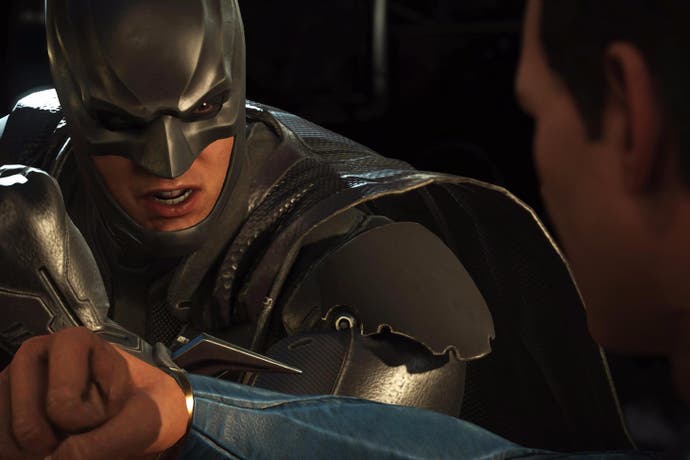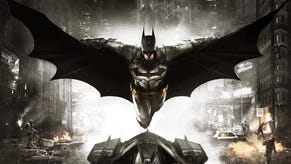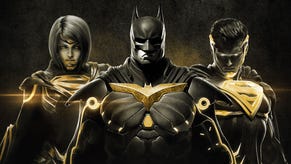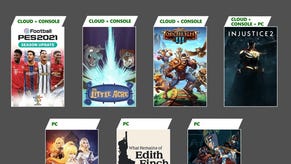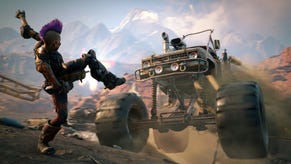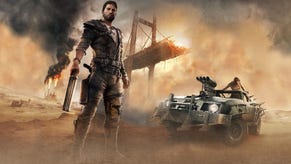Injustice 2 didn't need a story mode, but it delivered a blockbuster anyway
Carry on campaign.
Get over here!
Injustice 2 wants to grab you and never let you go. At heart, NetherRealm's superb superhero smackdown may be a classic one-on-one beat-em-up but that core experience has been pumped up into an absolute smorgasbord of play determined to monopolise your time. It boasts 29 combative DC comics characters, each requiring Tamagotchi levels of care and attention to level up.
Then there are the hundreds, if not thousands, of randomised gear items to collect from Mother Boxes. Limited-time events dangle additional loot if you can overcome wacky and/or gruelling gameplay modifiers. Plus daily challenges to complete, co-operative guilds to join and AI battle modes to manage. All the while, your XP bar keeps ticking upward like a cosmic Fitbit, tracking your progress through Injustice 2's gorgeously realised Multiverse. (At first glance, the only real misstep seems to be NetherRealm naming the main in-game currency 'credits' rather than 'Booster Gold'.)
Already a sales success at launch, Injustice 2's beefy suite of intertwined game modes suggests it has been consciously designed for the long haul, over and above the usual reliance on competitive online multiplayer and the drip-drip of additional DLC characters. True, when rearranging various pairs of Superman trousers across storage slots it can feel more like you're living out the fantasy of being Alfred on Justice League laundry day rather than embodying the brooding Dark Knight. But NetherRealm has created an impressive, integrated package that super-serves dedicated players with the time and determination to pour hundreds of hours intro tracking down Aquaman's most epic pauldron while also accommodating the casual players who just want to see Harley Quinn bash Batman with a massive hammer.

With all this going on, they could arguably have pulled a reverse Titanfall and ditched the traditional campaign mode for their sequel. Looking back, the story of the first game was actually a total bummer, set in a parallel universe where the Joker drugged Superman and tricked him into killing Lois Lane and their unborn child - a horrific incident designed to emphasize that Injustice: Gods Among Us was Dark and Mature rather than just a silly story of spandex slapsies. The grief-stricken Superman promptly murdered the Joker and became a globe-conquering despot, requiring an intervention from other heroes across the Multiverse to dismantle his fascistic Regime. With so many beloved characters getting bumped off or turning evil, this was a story gritty to the point of being indigestible.
What a pleasant surprise, then, that Injustice 2's campaign mode is such an accomplished and enjoyable experience, comparable to the best of the most recent flurry of comicbook movie blockbusters. Just to be clear, the Injustice franchise hasn't suddenly morphed into an irreverent, Guardians of the Galaxy-style knockabout romp: all that murder-y prehistory is still there, with Bad Superman locked up, Hannibal Lecter-style, in a power-dampening cell. But the storytelling is so confident, backed up with luxurious production design and effective facial animation, that it sets a new benchmark in fighting game fiction at a time when this particular art form seems to be in decline. (Street Fighter 5 launched without a story mode last year, although one was eventually patched in five months after release.)
Perhaps it also helps that there is an exterior threat, forcing the fractious surviving heroes to unite against a common foe. Brainiac is the arrogant galactic vivisectionist who violently uplifts his samples using a none-more-metal skull-shaped planet-killer. As voiced by Jeffrey Combs, the cult star of Re-Animator and veteran Star Trek actor, he is both odious and melodious, a coldly charismatic Big Bad. Telepathic ape Gorilla Grodd, glimpsed in the background in the previous Injustice, finally gets a more substantial role, which - along with appearances from mulch monster Swamp Thing and floaty mystic Doctor Fate - adds a more flamboyant charge to the story, some gonzo to match the gritty.
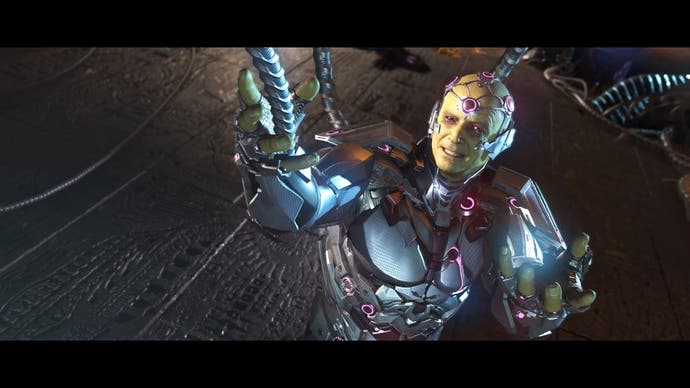
Injustice 2's campaign structure further refines the group story template NetherRealm pioneered in their 2012 Mortal Kombat reboot. As well as chapters spotlighting the prominent DC characters you might expect, there are also curveball double-acts thrown in to mix things up. That means some screwball bickering between vigilante couple Black Canary and Green Arrow, nervy young heroes Blue Beetle and Firestorm getting thrown in at the deep end and essentially a harrumph-off between equally self-regarding monarchs Aquaman and Black Adam.
Not everything about the campaign completely works. Some opponents are overused - let's just say glue-sniffing luchador Bane must have a good agent - and others literally beam in and out for a quick barney without any compelling story reason. But for the most part, it is a well-paced, surprising and often spectacular ride that even finds time to take a sly dig at the Arkham games. (Witnessing Batman deliver a typically emphatic beatdown on a goon, current Robin Damien Wayne drily observes: "So you won't kill, but you're fine with traumatic head injuries?")
It also pushes things forward in the right ways. Mortal Kombat X's campaign mode featured QTE moments during its narrative cutscenes but rather than adding to the interactive feel, they ended up just being a pain, requiring a level of stand-by vigilance that distracted from the story. Injustice 2 ditches that element so you can relax during cutscenes, right up until the camera floats over to the familiar side-on battle angle. Mortal Kombat X also featured more exaggerated, cartoonish character models most of whom looked like they might be related to Stretch Armstrong (admittedly, perhaps a deliberate attempt to mitigate some of the horrific X-ray-enabled violence it inflicted on its cast). In Injustice 2, some of the faces are almost distractingly realistic, unlocking a much larger range of expressions - from lip-curls to furrowed brows - that really add to the sense of immersion. The violence - though obviously over-the-top, especially during climactic supermoves - also seems rather less bloodthirsty.

In the world of Marvel and DC publishing, the term 'fight comic' is often used pejoratively to describe an issue that does nothing more than pit two characters against each other - presumably an easy paycheque for the writer and a real pain for the artist. To tick the single-player story box for Injustice 2, NetherRealm could have simply slapped together the game equivalent of a fight comic. Instead, they've demonstrated real ambition by staging their most grandiose campaign yet. They're also not daft: some light story branching means most players will feel compelled to play through the story at least twice. And they further sweeten the deal by throwing in some character-specific maximum level 20 loot once you complete each chapter, a carrot to go with their shtick.
But what if you miss the good old days, when part of the fun of familiarising yourself with a new beat-em-up game was systematically taking each of fighter through a series of scraps to see how their particular character story ended? Who can forget the rather weird sight of live-action orphans running through the snow after King at the end of Tekken 2? Someone at NetherRealm clearly decided that if they had the resources available to hire an artist to render dozens of bits of exquisitely detailed mossy body armour for Swamp Thing, they could splash the cash for some motion-comic endings. Buried somewhere amid Injustice 2's avalanche of content, there's Earth-1154, a battle simulation planet that offers up short but satisfying campaign endings for every character after as little as five fights in a row (on easy mode, if you must). Perhaps that's one of the upsides of building a game around the concept of a Multiverse. You can have the best of both worlds.
